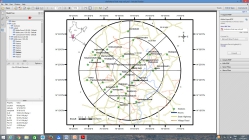Baseline Studies Around Kaiga Region
♦ An extensive database was established on the radiation level, and natural and artificial radionuclide concentrations in the terrestrial, aquatic, and atmospheric environmental matrices of Kaiga and the West Coast of India.
♦ The identification of natural plant species, Cymbidium aloifolium (L.), a lichen, and Petrobryopsis tumida (Hook.) Dix., a moss, in the tropical forest of the Kaiga region, as possible bio-indicators for monitoring natural and artificial radioactivity in the environment was made feasible.
Journal of Environmental Radioactivity, Vol. 31, No. 2, pp. 189-198, 1996.

Lichen - Cymbidium aloifolium (L.) |

Moss - Petrobryopsis tumida (Hook.) Dix |
♦ The presence of 137Cs in higher concentrations in the West Coast region of India in general, and around Kaiga region in particular was revealed, well before the nuclear power plant became operational. The reason for this was traced to the significantly higher rainfall, dense forest, higher soil organic matter, and the unique topography of Kaiga. This was considered as a very important finding because in the absence of such studies, and if the studies had been carried after the reactor became operational, the presence of higher 137Cs would have been wrongly interpreted as being released from the nuclear power station.
Radiation Physics and Chemistry, UK, Vol. 51, No. 4-6, pp. 623-624, 1998.
Health Physics, USA, Vol. 81, No. 2, pp. 148-155, 2001.
♦ The baseline database generated by the Mangalore University through extensive studies was very useful in the impact assessment of the Kaiga Nuclear Power Station on the environment, and helped in convincing the general public that there is no radiological impact on the environment due to this power plant.




















